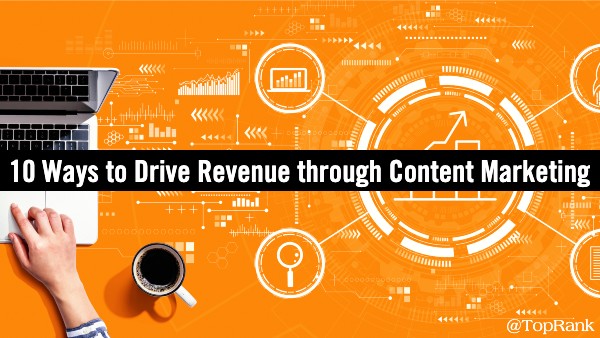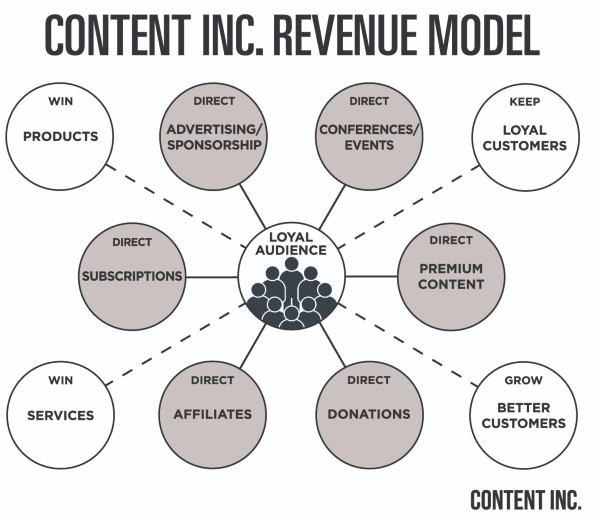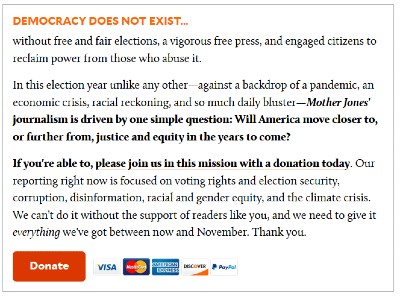
Huge congratulations to Joe Pulizzi on the release of the completely updated and expanded edition of Content Inc. Also thanks to Joe for contributing one of the handful of guest posts we’ve ever accepted here at TopRank’s B2B Marketing Blog. Along with thousands of other marketers, I’ve learned a lot from Joe and you will too.
Read on to discover 10 ways you can drive revenue for your business through content marketing from the Godfather of Content Marketing himself:
 Whether you are a marketing professional, content entrepreneur or a media executive, driving revenue from an audience is always the same. Once you build a loyal and trusting audience through your content marketing or media strategy, there are 10 different ways to generate revenue: six direct sources and four indirect sources.
Whether you are a marketing professional, content entrepreneur or a media executive, driving revenue from an audience is always the same. Once you build a loyal and trusting audience through your content marketing or media strategy, there are 10 different ways to generate revenue: six direct sources and four indirect sources.
Direct revenue options are generally aligned with media models. Indirect sources are considered the result of content marketing strategies. Regardless of what you “perceive” your organization to be, a smart content marketing professional should consider all 10 sources as options when building a content asset.
Direct Revenue Options
The six different methods by which companies can directly generate revenues from an audience group include advertising/sponsorship, conferences and events, premium content offerings, donations, affiliate sales, and subscriptions.
- Advertising/Sponsorship
The most popular method of driving direct revenues is through advertising and sponsorship programs—companies willing to pay you for direct access to your audience.
Traditional Advertising
Tested by time, traditional advertising still works very well, especially for those organizations with loyal, niche audiences.
- How to Cook That. Ann Reardon, the YouTube baking queen who now has more than 4 million subscribers to her YouTube channel How to Cook That, makes the majority of her revenues from YouTube advertising royalties. With very few resources, Ann was able to differentiate her message by focusing on what she calls “impossible food creations.”
- Morning Brew. The Morning Brew is a daily email newsletter built for millennials that combines business and lifestyle content with a quirky attitude. Each newsletter includes content-based advertising from brands written in the same style as the newsletter. Since its launch, the Morning Brew has added a number of targeted email newsletters and podcasts, increasing revenue from $3 million in 2018 to more than $20 million in 2020.
Sponsorships
While an advertisement generally involves interrupting a user’s experience with a product or content promotion, a sponsorship entails underwriting a piece of content, generally by one company. The benefits of sponsorships include getting leads (through a sponsored download) and/or achieving brand awareness (by sponsoring a podcast or television program).
- Content Marketing Institute. CMI favored a sponsorship model over an advertising model for the majority of its products. This included sponsored research reports, e-books, and webinars.
- Media Voices. UK-based Media Voices started as a weekly podcast designed for publishers in 2016. After launching at approximately $600 per sponsorship, it has evolved the model and charges about $3,000 per sponsorship today.
- Conferences and Events
According to CMI/MarketingProfs research, approximately 7 in 10 enterprises create and manage their own events. Some of these are small client gatherings, while others are full-scale events with exhibition halls and concurrent sessions. Revenues are mostly driven through paid event registration or sponsorships, such as parties or exhibition space.
- The Chicken Whisperer. Andy Schneider grew the Chicken Whisperer platform into a book, a magazine (with more than 60,000 subscribers), and a radio show, which has now run for more than seven years with more than 20,000 weekly subscribers. But sponsored road shows are a core part of his revenue mix.
- Inkers Con. After launching multiple bestselling books and a popular book publishing training course, Alessandra Torre created the event Inkers Con Authors Conference. “If you can make it through that first year, the second year [is] so much easier. We made all of our mistakes in the first year, and it still ended up being a fantastic event,” says Torre. The 2019 physical conference sold 400 tickets, while the 2020 virtual event sold 750 tickets at $245 per person.
- Lennox Live. Lennox is one of the largest manufacturers of heating and air-conditioning equipment in the world. Every year, the event attracts the leading contractors and distributors from across the United States, offering education around technology, marketing, and business practices. Exhibiting partners include companies such as Honeywell, Cintas, and Fluke. Lennox generates revenue directly from attendee fees, as well as from more than a dozen manufacturing and service partners.
- Premium Content
Premium content packages come in a number of forms, including direct-for-sale content products and syndicated content opportunities.
Content Products
- Digital Photography School (DPS). Darren Rowse launched DPS as the leading source for beginning photographers, showing them how they can get the most out of their picture-taking skills. DPS generates millions per year by developing premium e-books and specialty reports for direct sale. DPS’s premium content sales have become core to the company’s monetization strategy.
- BuzzFeed (Tasty). One of the ways BuzzFeed monetizes is through customized cookbooks. BuzzFeed launched Tasty: The Cookbook, a hard-copy book that buyers can customize to fit their tastes. Just a few weeks after initial launch, BuzzFeed sold more than 100,000 copies of the cookbook.
Syndicated Content
Content syndication happens when third-party websites pay a fee to publish original created content.
- Red Bull. Red Bull’s “Content Pool” contains thousands of videos, photographs, and pieces of music to which media companies and content producers can purchase rights, directly from Red Bull.
- Scott Adams. The Dilbert creator is now a multimillionaire who draws revenue through speaking and writing books, in addition to comic strips. Adams got his start by syndicating the popular Dilbert cartoon to newspapers and websites around the globe.
- Donations

Generally, donations to subsidize an organization’s publishing work best for not-for-profit and cause organizations.
- Pro Publica. Pro Publica is a nonprofit organization that uses its funding to develop investigative journalism. Founded by Paul Steiger, former managing editor of the Wall Street Journal, Pro Publica employs more than 50 journalists and received its major funding from the Sandler Corporation, which committed funding for multiple years at Pro Publica’s launch. Pro Publica also accepts ongoing donations from anyone that believes in the organization’s cause.
- Mother Jones. Like Pro Publica, Mother Jones receives most of its funding through direct reader donations (Figure 18.2), and it includes a call to action at the end of every article.
- Cards Against Humanity. In 2013, the card game ran a “Give Cards Against Humanity $5 Sale,” where they asked their audience for 5 dollars in exchange for absolutely nothing. They made over $70,000 without selling a thing.
Microfunding
- Kickstarter/Go Fund Me. Retired US Army officer Brian Stehle dreamed of writing a children’s book, but he needed funds to pay for the up-front production. Brian turned to Kickstarter, asking friends and family to donate the $4,200 in startup costs. It only took a few days for Brian to achieve his goal. Now his children’s Christmas book, One Day Off, is a reality.
- Creator Coins. Creator coins or token allows the owner to control and coordinate the value of their brand and content across all networks. Companies like Rally.io mint a coin on the Ethereum (ERC-20) network and then give access to the owner to share the coin with their community. Most times, the coins give the audience get access to unique prizes or events, but as the network grows, some coins begin to collect significant value. We’ve had great success with our own creator coin, $TILT coin, and partnered with Rally for the roll out. This is in the early stages, but there is true potential in this space. NFTs (non-fungible tokens) like these have already taken off in the art space on sites such as SuperRare, MakersPlace and OpenSea.
- Affiliate Sales
Affiliate income works like this: if you click on my affiliate link and sign up for the products and services I recommend, then I earn a commission.
- Entrepreneurs On Fire (EOF). EOF is the popular podcast series run by John Lee Dumas. John promotes a number of companies that pay an affiliate fee to John on either click or actual product sale. EOF publishes revenues and profits every month.
- The Wirecutter. The Wirecutter, the gadget and deal listing site, was purchased by the New York Times in 2016 for $30 million. The site makes a little bit of money every time it sells a product recommended on the site. These deals add up. In 2015, it generated more than $150 million from affiliate revenues.
- BuzzFeed. According to the Wall Street Journal, BuzzFeed collected more than $300 million in 2019 solely from affiliate links.
- Subscriptions
Subscriptions differ from premium content in that subscriptions, paid for by the consumer, promise to deliver content over a period of time (generally a year).
- Copyblogger. After selling its software products division, Brian Clark focused Copyblogger’s revenue on education and training, creating Copyblogger Pro, an annual membership program that includes foundational training, monthly advanced marketing master classes, and ongoing coaching for $495 per year.
- Agency Management Institute. Owner Drew McLellan has a number of revenue drivers for his business, including sponsorships and events. The main lever is an annual membership where agency owners get the opportunity to meet with other agency owners in private meetings throughout the year. There are multiple levels of membership, with the highest at $3,000 per year.
- The Hub. Launching the site initially as a UK Facebook group, Laura Moore and Laura Davis created The Hub, a membership site for social media managers. “We targeted 50 members for the first three months, but exceeded 100,” says Moore. They completed their first year as a membership site with approximately $300,000 in income.
Indirect Revenue Options
While direct revenue options have been traditionally considered part of the media company model, indirect revenues fall under the approach known as content marketing. This means you don’t make money directly from the content, but from the effect of the content over time.
- Product Sales
- Chili Klaus. Claus Pilgaard, aka Chili Klaus, is one of the best-known celebrity figures in Denmark, all because of the extraordinary way he talks about chili peppers. Claus’s YouTube videos have garnered millions of views, including one where Claus conducts the Danish National Chamber Orchestra playing “Tango Jalousie” while eating the world’s hottest chili peppers. That video alone has seen more than 5 million views. From this success, Claus has launched a suite of successful products under the brand “Chili Klaus,” including chili chips, chili sauce, chili licorice, and dozens of other products.
- Indium Corporation. Indium, a global manufacturing company headquartered in upstate New York, develops and manufactures materials used primarily in electronics assembly. At its core, the company develops soldering materials to keep electronic components from coming apart. Rick Short, Indium’s director of marketing communications, knew that Indium employees had more knowledge about industrial soldering equipment than just about any other company in the world. This makes sense. Soldering is the knowledge area where Indium manufactures most of its products. Indium believed that if it published its expertise on a regular basis, it would draw in new customers and have opportunities to sell more products. Today Indium’s blog From One Engineer to Another is the company’s leading driver of new product sales.
- Missouri Star Quilt Company. Jenny Doan is the cofounder of the Missouri Star Quilt Company, a quilt shop in Hamilton that boasts the largest selection of precut fabrics in the world. To spur sagging sales, Jenny created quilting video tutorials to post on YouTube. The videos have driven new traffic to the shop’s website, gaining an average of 2,000 online sales per day and making it the world’s largest supplier of precut fabrics (worth almost $200 million a year).
- MrBeast. After developing one of the most successful YouTube channels in history with over 50 million subscribers, MrBeast (aka Jimmy Donaldson) launched MrBeast Burger in over 300 locations simultaneously.
- Services Sales
- Game Theory. Today Matthew Patrick’s Game Theory brand has more than 8 million subscribers. From this success, Matthew launched Theorists Inc., a specialty consulting firm that works with large brands that want to be successful on YouTube. Theorists Inc. has been hired directly by some of the biggest YouTube stars on the planet to help them attract more viewers, as well as has been hired by a number of Fortune 500 companies. Even the mighty YouTube itself hired Theorists to consult directly on helping YouTube retain and grow its audience numbers.
- Smart Simple Marketing. Sydni Craig-Hart launched Smart Simple as a marketing consulting firm with her husband, Will, in 2006. Today Smart Simple is one of the leading marketing agencies focused on diversity issues. How did it get there? “We’ve actually produced 439 [content-based] programs over the last 14 years,” says Sydni. That kind of consistent delivery led to a weekly email newsletter with more than 30,000 subscribers:
- Loyalty Revenue

Of all the revenue drivers of this approach, loyalty is the oldest of them all, and it is still extremely important today. Organizations of all sizes originally launched print magazines to keep customer loyalty over time.
- John Deere’s The Furrow Magazine. John Deere launched The Furrow magazine in 1895. It is still published today, produced in print and digital format in 14 different languages and distributed to 40 countries. The Furrow has always focused on how farmers can learn the latest technology to grow their farms and businesses. Over the past 100 years, just a handful of the articles have been about John Deere products and services.
- Harley-Davidson’s The Enthusiast magazine. Harley-Davidson Motorcycles has one of the most loyal followings in the world. One reason is its print and digital magazine, The Enthusiast (formerly HOG magazine). The magazine, first published in 2016, is now sent every quarter to 650,000 customers.
- Increased Yield on Current Customers
Once acquiring a customer, innovative companies leverage customer data to deliver targeted and consistent publications to, in essence, create better customers over time.
- thinkMoney from TD Ameritrade. Some investing services are conservative and buttoned-down, especially in complex derivatives markets, but thinkMoney follows a different approach. It takes the subject of investing seriously, but it doesn’t take itself with the grim seriousness of many Wall Street firms. Instead, thinkMoney embraces a “sophisticated simplicity” approach that’s edgy without being flippant, and witty without being irreverent. Research from T3, thinkMoney’s publisher, found that those who read the magazine trade five times more often than those who do not.
- Fold Factory. Trish Witkowski, CEO of Fold Factory, has become a celebrity in the direct mailing industry through her regular video show, The 60-Second Super Cool Fold of the Week, where she details amazing examples of print direct mail. In 2020, Trish hit the 500th episode of the series, which marked 10 years of production and the creation of 500 different T-shirts, which she sells. The Fold Factory videos have been directly responsible for more than $750,000 in revenue.
The most successful content creators leverage not one, but multiple streams of revenue. Whether you consider yourself a marketer or part of a media company, we are all publishers. Just as an investor diversifies a portfolio with multiple stocks and/or mutual funds, content creators need to diversify the revenue streams generated from their content and audience building.
 Joe Pulizzi’s new book, Content Inc.: Start a Content-First Business, Build a Massive Audience, and Become Radically Successful (with Little to No Money) Is Available Now.
Joe Pulizzi’s new book, Content Inc.: Start a Content-First Business, Build a Massive Audience, and Become Radically Successful (with Little to No Money) Is Available Now.
Joe is also the founder of The Tilt, a newsletter dedicated to helping content creators find a business model.



